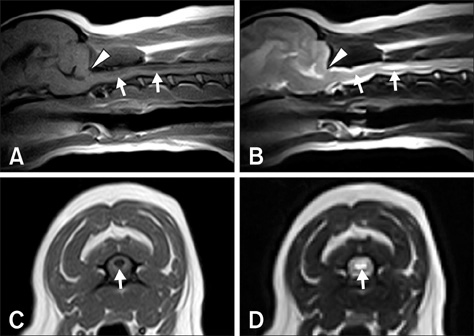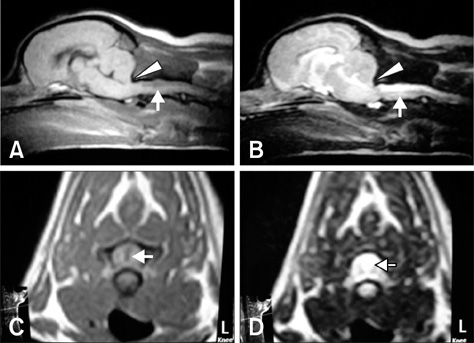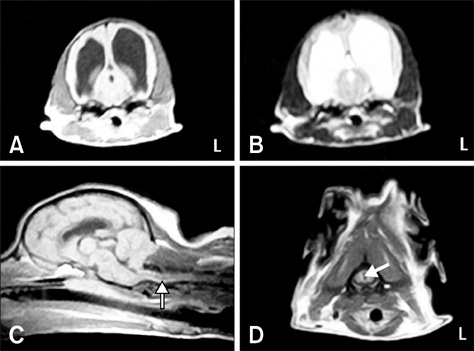J Vet Sci.
2009 Dec;10(4):365-367. 10.4142/jvs.2009.10.4.365.
Syringomyelia in three small breed dogs secondary to Chiari-like malformation: clinical and diagnostic findings
- Affiliations
-
- 1Department of Medicine and Epidemiology, School of Veterinary Medicine, University of California, Davis, CA 95616, USA.
- 2BK21 Basic & Diagnostic Veterinary Specialist Program for Animal Diseases and Department of Veterinary Internal Medicine, College of Veterinary Medicine, Konkuk University, Seoul 143-701, Korea. parkhee@konkuk.ac.kr
- KMID: 1726913
- DOI: http://doi.org/10.4142/jvs.2009.10.4.365
Abstract
- Three small breed dogs were referred for the evaluation of neurologic deficits. Upon physical and neurologic examination, all dogs displayed hyperesthesia, pain, and neck stiffness. Magnetic resonance imaging was performed on the brain and spinal cord, and all three dogs presented Chiari-like malformations and syringomyelia. These dogs were treated with prednisolone and furosemide, and showed rapid improvement of clinical signs. Chiari malformations and syringomyelia were not improved because of congenital disorders. This case report demonstrates the clinical and diagnostic features of Chiari-like malformations and syringomyelia in three small breed dogs.
Keyword
MeSH Terms
Figure
Reference
-
1. Churcher RK, Child G. Chiari 1/syringomyelia complex in a King Charles Spaniel. Aust Vet J. 2000. 78:92–95.2. Dewey CW, Berg JM, Barone G, Marino DJ, Stefanacci JD. Foramen magnum decompression for treatment of caudal occipital malformation syndrome in dogs. J Am Vet Med Assoc. 2005. 227:1270–1275.
Article3. Dewey CW, Berg JM, Stefanacci JD, Barone G, Marino DJ. Caudal occipital malformation syndrome in dogs. Compend Contin Educ Pract Vet. 2004. 26:886–896.4. Milhorat TH, Kotzen RM, Mu HT, Capocelli AL Jr, Milhorat RH. Dysesthetic pain in patients with syringomyelia. Neurosurgery. 1996. 38:940–947.
Article5. Nakamura M, Chiba K, Nishizawa T, Maruiwa H, Matsumoto M, Toyama Y. Retrospective study of surgery-related outcomes in patients with syringomyelia associated with Chiari I malformation: clinical significance of changes in the size and localization of syrinx on pain relief. J Neurosurg. 2004. 100:241–244.
Article6. Rusbridge C. Neurological diseases of the Cavalier King Charles spaniel. J Small Anim Pract. 2005. 46:265–272.
Article7. Rusbridge C. Chiari-like malformation with syringomyelia in the Cavalier King Charles spaniel: long-term outcome after surgical management. Vet Surg. 2007. 36:396–405.
Article8. Rusbridge C, Carruthers H, Dubé MP, Holmes M, Jeffery ND. Syringomyelia in cavalier King Charles spaniels: the relationship between syrinx dimensions and pain. J Small Anim Pract. 2007. 48:432–436.
Article9. Rusbridge C, Greitz D, Iskandar BJ. Syringomyelia: current concepts in pathogenesis, diagnosis, and treatment. J Vet Intern Med. 2006. 20:469–479.
Article10. Rusbridge C, Jeffery ND. Pathophysiology and treatment of neuropathic pain associated with syringomyelia. Vet J. 2008. 175:164–172.
Article11. Stanfa LC, Dickenson AH. In vivo electrophysiology of dorsal-horn neurons. Methods Mol Med. 2004. 99:139–153.
- Full Text Links
- Actions
-
Cited
- CITED
-
- Close
- Share
- Similar articles
-
- Magnetic resonance imaging features of syringobulbia in small breed dogs
- Chiari Type I Malformation in a Child with Syringomyelia and Scoliosis: A case report
- Treatment of Syringomyelia due to Chiari Type I Malformation with Syringo-Subarachnoid-Peritoneal Shunt
- A Case of Chiari Type 1 Malformation and Syringomyelia in Neurofibromatosis Type 1 Patient
- Anesthetic management of a patient with Arnold-Chiari malformation type I with associated syringomyelia: A case report




